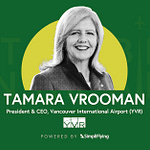In this episode of our ‘Sustainability in the Air’ podcast, André Stein, Chief Strategy Officer at Eve Air Mobility, speaks with SimpliFlying CEO Shashank Nigam, and shares how electric vertical takeoff and landing (eVTOL) aircraft and electrification could lead to more sustainable and efficient flying.
Eve began in 2017 as a project within aircraft manufacturer Embrarer’s market accelerator program, Embraer-X. Eve’s aim is to reimagine urban air mobility (UAM) and deliver a seamless end-to-end experience, while creating a safe, sustainable and accessible mode of travel.
Stein envisions eVTOL as an alternative transportation option for occasional use, rather than a replacement for mass transportation.
Here are the key highlights of the conversation:
Passenger experience and accessibility (3:10)
Eve’s carrying capacity and planned routes (6:53)
Current state of the certification and testing (9:35)
Eve’s partnerships across the globe (11:46)
Bringing about the eVTOL transition (18:26)
How electric aircraft lead to more efficient flying (22:19)
Disruption of urban mobility and accessibility. (27:00)
How much does it cost to get on an Eve eVTOL? (31:16)
Holistic approach to sustainability (42:14)
Rapid Fire! (45:30)
Keep reading for a quick overview of the episode.
Why electrification matters
Eve’s eVTOL will initially carry four passengers plus a pilot, but the design allows for a future transition to an autonomous aircraft carrying up to six passengers. Commercial operations are targeted to start around 2026.
Increased efficiency and noise reduction: Stein discusses how electrification revolutionises aircraft design, allowing for more freedom and efficiency compared to traditional helicopters. The design of Eve’s eVTOL involves a lift plus cruise system, which is significantly more energy-efficient and quieter – offering 6x lower cost-per-seat and 90% lower noise footprint than traditional helicopters!
Better application of battery technology: Stein explains that the current battery technology is well-suited for UAM due to the short-haul nature of the missions. Eve currently covers a range of 60 miles. Evolving battery technology will only make the aircraft more efficient in the future, he adds.
Affordable for everyone: Stein argues that electrification significantly reduces operational costs, such as fuel and maintenance, making eVTOLs a viable option for a wider section of the population. The cost per ride could be comparable to taking a taxi or rideshare, depending on the region and operational costs.
Simpler design and lower maintenance costs: Traditional helicopters being complex machines have higher cost of fuel and maintenance, explains Stein. eVTOLs, on the other hand, have simpler designs that make them both energy and cost efficient. Moreover, increasing demand would further drive down costs, making eVTOLs more accessible.
5 ways Eve is re-imagining the future of urban mobility
1. Ensuring a great passenger experience
Stein emphasises that enhancing passenger experience has been central to Eve’s design philosophy. Their goal is to not just provide a solution for people to move around the city, but to also be mindful of people with special needs like wheelchair users, the visually impaired, the elderly, and pregnant women.
Eve has run simulations using current helicopters to map the user journey from onboarding a car, going through the airport, and getting inside an aerial vehicle. They have also collaborated with Delft University, Amsterdam to understand and address motion sickness.
“User experience has been since the very beginning of this programme one of our key areas of focus, right? It’s not about the technology, it’s really about delivering a solution, an option for people to move around the city, and understand the different needs when it comes to how that experience will be.”
2. Leveraging Embraer’s expertise
Embraer’s expertise and support has been invaluable to Eve’s journey. Eve has royalty-free access to Embraer’s intellectual property, and quite a bit of Eve’s development work was outsourced to Embraer’s skilled engineers. Eve can also utilise Embraer’s existing infrastructure and services, which would’ve otherwise taken decades to set up, states Stein. That’s not all. Eve also has access to Embraer’s test facility – one of the largest in the southern hemisphere.
“So that’s a great combination that really gives us our edge, not to mention access to all the existing infrastructure for support. Once you enter the market for service and support, to build up such a structure from scratch, you’ll take decades, probably in hundreds of millions of dollars. So you have from day one access to that.”
3. Looking at sustainability from a lifecycle perspective
Explaining their holistic sustainability approach, Stein says that building an electric aircraft with zero local emissions is the starting point for a larger vision. Keeping sustainability at the heart of the business, Eve assesses the entire life cycle of the aircraft – from cradle to grave, and evaluates the carbon footprint of its entire supply chain.
The company is also looking for ways to give batteries a second life, and utilising their residual energy once they are no longer fit to power aircraft. Such batteries can be used at vertiports, for example, as stationary batteries to recharge vehicles, explains Stein. Through careful material selection; using recyclable materials like cork, recycled flip-flops, natural wool; and harmless disposal, Eve reduces resource consumption and promotes a green economy, he adds.
The eVTOL company is also a part of a coalition to study the impacts of UAM, and is collaborating with the World Economic Forum on its Target True Zero mission, states Stein.
4. Nurturing the right partnerships
In September 2022, United Airlines announced it would invest $15 million in Eve. The airline also signed a conditional purchase agreement for 200 of Eve’s aircraft and options to buy 200 more.
In addition to United, Eve has a global footprint with different partners and business models around the world. Impressively, it has customers on every continent. It is working with Kenya Airways and their innovation arm, Fahari Aviation; regional airlines like Republic Airways and SkyWest; helicopter operators like Helisul and Bristow; and is collaborating with BLADE India to build a UAM ecosystem in India.
In April 2023, Eve also hosted a summit in Florida to bring together industry players to explore the future of UAM, and build the necessary infrastructure to support it. Stein says that in less developed markets such as Africa and India urban air mobility could provide a revolutionary jump in mobility options. He also mentions the potential of eVTOLs in the United Arab Emirates, acknowledging that while it may not be the largest market, it could be an interesting one to start with due to its pioneering nature.
5. Launching with “pioneer cities”
Eve plans to commence commercial operations in 2026. However, the company does not plan to operate its eVTOLs all by itself – clients across the globe will operate Eve’s eVTOLs. Eve is in discussions with infrastructure providers and city representatives to understand market demands, and work out “pioneer cities” for the product launch.
To further build the UAM market, Eve is collaborating with MIT to estimate the potential demand and to develop marketing and data-driven models to assess and address the challenges involved.
‘Sustainability in the Air’ is the world’s leading podcast dedicated to sustainable aviation. Through in-depth conversations with top aviation leaders, we break through the clutter and provide a clear roadmap for a net-zero future.
This episode of the podcast is brought to you by Travelport, a global technology leader that powers bookings for travel suppliers worldwide. Their travel retailing marketplace, Travelport+, empowers travel retailers to understand and communicate the most sustainable travel options.














